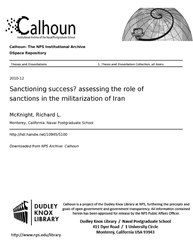File:Sanctioning success? assessing the role of sanctions in the militarization of Iran (IA sanctioningsucce109455100).pdf

Original file (1,275 × 1,650 pixels, file size: 713 KB, MIME type: application/pdf, 104 pages)
Captions
Captions
Summary
[edit]| Sanctioning success? assessing the role of sanctions in the militarization of Iran
( |
||
|---|---|---|
| Author |
McKnight, Richard L. |
|
| Title |
Sanctioning success? assessing the role of sanctions in the militarization of Iran |
|
| Publisher |
Monterey, California. Naval Postgraduate School |
|
| Description |
In its three decade history, the Sepah-e Pasdaran-e Englab Eslami, or Islamic Revolutionary Guards Corps, evolved from the relatively modest role of ad hoc security apparatus into its current state as an independent and professional, armed force enmeshed in the political and economic life of modern Iran. In tracing the history of the Guards, one cannot help but take note of how multiple rounds of U.S. sanctions have set the stage for this transformation. Sanctions imposed under the Carter and Reagan administrations created a defense gap by first severing ties between the Iranian and U.S. defense industries and then choking the flow of U.S. war materiel through intermediaries. The Guards, buoyed by their connection to Iranian defense conglomerate DIO, rose with the tide of domestic wartime spending; emerging from the Iran-Iraq War with a considerable construction and manufacturing base. The Guards were then able to leverage this base to dominate postwar reconstruction in Iran, spurred by a gap in foreign development activity exacerbated by the Clinton era sanctions. Today, smart sanctions appear to continue this trend by the creation of a finance gap that is tilting the ongoing privatization of Iran's burgeoning public sector squarely in favor of the Guards. Subjects: Politics, Practical |
|
| Language | English | |
| Publication date | December 2010 | |
| Current location |
IA Collections: navalpostgraduateschoollibrary; fedlink |
|
| Accession number |
sanctioningsucce109455100 |
|
| Source | ||
| Permission (Reusing this file) |
This publication is a work of the U.S. Government as defined in Title 17, United States Code, Section 101. As such, it is in the public domain, and under the provisions of Title 17, United States Code, Section 105, may not be copyrighted. | |
Licensing
[edit]| Public domainPublic domainfalsefalse |
This work is in the public domain in the United States because it is a work prepared by an officer or employee of the United States Government as part of that person’s official duties under the terms of Title 17, Chapter 1, Section 105 of the US Code.
Note: This only applies to original works of the Federal Government and not to the work of any individual U.S. state, territory, commonwealth, county, municipality, or any other subdivision. This template also does not apply to postage stamp designs published by the United States Postal Service since 1978. (See § 313.6(C)(1) of Compendium of U.S. Copyright Office Practices). It also does not apply to certain US coins; see The US Mint Terms of Use.
|
 | |
| This file has been identified as being free of known restrictions under copyright law, including all related and neighboring rights. | ||
https://creativecommons.org/publicdomain/mark/1.0/PDMCreative Commons Public Domain Mark 1.0falsefalse
File history
Click on a date/time to view the file as it appeared at that time.
| Date/Time | Thumbnail | Dimensions | User | Comment | |
|---|---|---|---|---|---|
| current | 12:22, 24 July 2020 |  | 1,275 × 1,650, 104 pages (713 KB) | Fæ (talk | contribs) | FEDLINK - United States Federal Collection sanctioningsucce109455100 (User talk:Fæ/IA books#Fork8) (batch 1993-2020 #27064) |
You cannot overwrite this file.
File usage on Commons
The following page uses this file:
Metadata
This file contains additional information such as Exif metadata which may have been added by the digital camera, scanner, or software program used to create or digitize it. If the file has been modified from its original state, some details such as the timestamp may not fully reflect those of the original file. The timestamp is only as accurate as the clock in the camera, and it may be completely wrong.
| Short title | Sanctioning success? assessing the role of sanctions in the militarization of Iran |
|---|---|
| Author | McKnight, Richard L. |
| Software used | McKnight, Richard L. |
| Conversion program | Acrobat Distiller 8.2.5 (Windows) |
| Encrypted | no |
| Page size | 612 x 792 pts (letter) |
| Version of PDF format | 1.4 |

